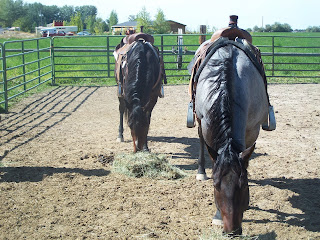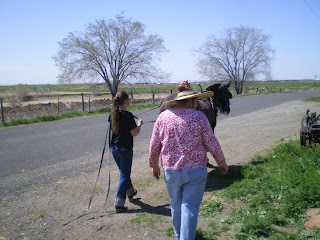For nine years now, my heart has belonged to 4-H and the Agricultural
Industry. My life goal is to be a cattle producer, to promote, advocate, and to
lobby for every aspect of that industry, which includes the Farmer, Rancher,
and let us not forget Rodeo.
Rodeo, Rodeo! You may be asking yourself, how does Rodeo play into the
Agricultural Industry.
Rodeo’s history here in the USA
comes from the American cowboy. Ranchers from the Southwest would organize long
cattle drives, to bring cattle to the stockyards in towns like Kansas City, where trains would carry the
cattle east. “This was the golden age of the cowhand, who made their living on
the many ranches and cattle trails such as the Chisum, Goodnight-Loving, and
the Santa-Fe. At the end of the long trails, these new American
"Cowboys" would often hold informal competitions among themselves and
the various different outfits to see which group had the best riders, ropers
and all-around best drovers. It would be from these competitions that modern
rodeo would eventually be born.”
The modern day rodeo’s do not just happen they take countless hours to
organize, to find sponsors, and to promote. The person who organizes the rodeos
does it all, but they also count on a team of people who volunteer their time
for the love of the sport of Rodeo.
One of those volunteers and the myth I would like to dispel is the young
woman once known as the Rodeo Queen. Once upon a time a long long time ago
Rodeo queens in
the first years were chosen from a selected group of princesses who competed
for the prize by selling raffle tickets for a steer. The young woman who sold
the most tickets was the queen. This is a fact, but NO longer true, and the
person once known as the Rodeo Queen has evolved over the years.
This year
I decided to encompass Rodeo into my promotion, advocating, and to
lobbing efforts for the Agricultural Industry. My family has along history of
rodeo participation, so I entered my first Rodeo Royalty Contest. For 30 days,
I studied the Professional rodeo Cowboys Association rulebook (282 pages), PRCA
Media Guide (543 pages) wrote a speech, worked on my modeling skills, got my
fingernails done, learned how to fix my hair, and got the clothes needed to
compete. I road and worked with my horse Custer, and as many different horses
as I could find to ride. Let me tell you the day of what I thought was a
contest I got up at 5 A.M., did my hair and makeup, got dressed and off I went,
only to realize that it was a job interview. Those young women you see in
parades are all business; the job that these young women are applying for; is
no longer called Rodeo Queen, they are now known as Rodeo Ambassadors, and
their job is to promote.
I had the pleasure of meeting
Hali Stutzman Gooding
County Rodeo Ambassador while at the first competition.
 |
| Hali Stutzman |
Hali politely granted me an interview on a year in
the life of a Rodeo Ambassador. Hali: “I feel that it is important that
those who are interested in becoming rodeo ambassadors realize that it is a
job; it is the most exciting hard working job I have ever had. I travel nearly
every weekend representing my title and I work hard to keep my rodeo manager/director
happy by representing to the best of my ability possible. Last year I traveled
over 8,000 miles; it is not just representing a rodeo or fair, it is the entire
sport of rodeo and western way of life. There is a lot of pressure to hold your
actions to a higher standard. I study everyday, some days it is an hour others
it is 5 or 6 hours. Topics of veterinary science, equine nutrition, PRCA
rulebook, PRCA media guide, current events. As well as various questions in
personality. I also practice modeling for at least a half hour a day, and I try
to ride as many different horses as possible to prepare for the draw horses
they use for horsemanship at this level. In addition, a lot of work goes into
my clothes, I design a lot of them and my mom sews most of them. I very rarely
buy anything; it is extremely expensive to buy clothes for being an
ambassador so we have worked our own system to be able to afford this job.”
It sounds like it's more work than it is fun; but that is completely false. I
have met some truly amazing people in my travels that I am lucky to call my
friends now, from media personnel, bullfighters, announcers, stock
contractors, to other ambassadors but most important the rodeo fans. Signing
autographs for the spectators of the great sport of Rodeo is so rewarding, I
hear great stories from so many different people. Rodeo is a great family sport
and it shows in every crowd I see.” Before I began competing for titles, I had
a bad attitude and was extremely shy. Thanks to all my years as an ambassador,
I have built my confidence and can make friends with almost any stranger I
meet. It has also taught me how hard you have to work for your dreams.”
After talking to Hali and the rest of those, interviewing for the job of
Rodeo Ambassador, those beautiful young women in sequins, cowboy hats and with
a smile that lights up a room, remember there is also knowledge of the sport of
rodeo, agriculture, the western family values and so much more.
After meeting Hali Stutzman, I know that I will be participating in another
Rodeo Ambassador Contest (interview) until I get the job! I learned a lot and
had a great time doing it.
The next time you see those sequins, and cowboy hats; just remember that
every job has a uniform, and that is the uniform of a Rodeo Ambassador.






















































